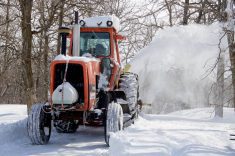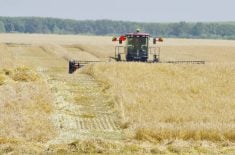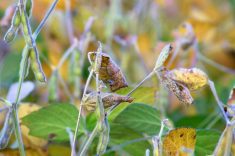Overview
Harvest progress sits at 40 per cent completed across the province, approximately 3 weeks behind the 5-year average of 71 per cent complete by week 38.
Steady rainfall across the province late last week stalled harvest progress. Farmers are anxiously awaiting drier weather to return to straight-cutting cereal and canola crops, and for breezy days to dry down damp swaths.
Read Also

Seeding Indigenous agricultural prosperity
National Circle for Indigenous Agriculture and Food says Indigenous agricultural success needs strong relationships.
Canola harvest has been slow to ramp up – rain delays, high humidity, and soft fields have prevented the jump in harvested acres, but good progress has been made in the Central, Eastern, and Northwest regions.
Cereals
Winter cereal grains
Winter cereal harvest is complete.
Seeding fall rye and winter wheat has started, primarily on canola stubble. Seedbed conditions are good, and recent rains will rapidly germinate planted crops.
Spring cereal grains
Spring wheat harvest is ongoing in all regions, and wrapping up in the central region as producers move into canola crops. Good harvesting weather has aided producers, and grain quality remains high.
CWRS wheat is mostly grading No 1, protein has ranged between 13.5 to 14.8 per cent.
Spring cereal harvest progressed rapidly until Friday, and slowed or stopped over the weekend with frequent showers and high humidity. Spring wheat is approximately 65 per cent harvested.
Wheat yield averages are reported between 60 to 70 bu/acre across the province.
Oat harvest has progressed slowly this week. Farmers are reporting widespread average yields that are slightly below expectations, generally averaging 120 to 130 bu/acre, with test weights in the 44 to 48 lb/bu range.
Remaining oat crops are mostly swathed, but those still standing for direct harvest have seen substantial lodging and straw breakage – depending on seeding date and recent rainfall. Some quality downgrading is expected.
Corn
Corn development has reached R5 (dent) stage, with the milk line one-third to halfway down the kernel depending on hybrid.
Some mid-May planted corn hybrids near Morden have reached physiological maturity (black layer).
Silage cutting has started near Beausejour, but wet fields are making efficient machine operation difficult.
Oilseeds
Canola
Canola harvest has progressed slowly across the province, and pre-harvest desiccation continues to advance crop drydown in a timely manner.
Canola harvest progress rose slightly faster in the Central and Northwest regions.
Yields in the Central and Eastern regions are between 35 to 50 bu/acre, with averages in the mid forties.
Interlake canola yields have been disappointing for many, average yield is approximately 30 bu/ac in the Arborg area, and slightly below expectations at 40 bu/ac in the southern portion of region.
Extreme flea beetle feeding and environmental stress on the earliest canola crops has negatively
impacted yield, and yield reductions compared to later seeded canola are common and expected by many.
Flax & sunflowers
Swathing has started for some flax crops, the remainder of the crop is still standing and drying down.
Sunflowers are in the R7 to R9 stages. Crops appear uniform, except in areas where spring rains drowned out emerging plants. Crops are not yet ready for desiccation, and yields are expected to be average.
Pulses
Most soybean fields have turned colour, leaf drop is widespread on crops planted before the beginning of June and moving past the risk of frost damage. Later-planted crops still have green leaves, but are turning colour in the R7 to R8 stages.
Early soybean harvest has commenced in some parts of the Central region, no yields reported to date.
Ag retailers have commented that if weather conditions do not improve to speed crop drydown once at R9, dessicant use may be considered.
Field pea harvest virtually complete. Average yield vary widely by soil type and local district, with two common yield bands: 50 to 60 bu/acre, and 70 to 80 bu/acre.
Dry bean harvest is well underway in the Central region. Very good yields reported, with many bean classes yielding between 2,000 to 3,000 lbs/acre.
The record average yield for dry beans in Manitoba was set in 2017 at just over 2,100 lbs/acre, and dry bean crops could exceed that mark this year.
Forages & livestock
Forages
Cattle producers are still putting up feed, and yields remain above average.
Polycrop, barley and oat silage cutting is underway. Corn silage-making has started in limited areas, primarily near Beausejour in the Eastern region.
Baling straw and greenfeed has been a challenge with frequent light showers and poor drying conditions.
Livestock
Grass pasture growth has benefitted from cooler conditions and recent rain, putting on enough growth in many areas to sustain fall grazing.
Dugouts and sloughs are at 60 to 70 per cent capacity in the Southwest region, while creek flows have slowed.
Livestock water supplies remain sufficient in all parts of the province.
Regional comments
Southwest
Several rainy days last week stopped harvest activities. Most parts of the region received at least 10 mm rainfall, with up to 40 mm near Forrest and Kenton. Field access was limited in parts of the region. Seasonal daytime temperatures, together with cool overnight lows have farms concerned about late-planted crops maturing ahead of a killing frost. However, no frosts have arrived to date. Fall-seeded rye and winter wheat crops are germinating well with recent rains.
Northwest
A slower week of harvest progress with fall weather affecting harvesting hours. The week started with a light frost in some parts of the region near Swan Valley, Birch River, Grandview and San Clara. Although most crops have reached maturity and are safe from injury, there were some later soybean crops that may be affected. Most of the region received precipitation setting in Wednesday and scattered showers continued off and on through the week. Heavy morning dew and cloudy, humid days also contributed to the slow harvest progress, with the exception of The Pas, where little to no precipitation arrived and allowed harvest to progress.
Central
Steady rains ahead of the weekend stopped harvest progress across the region. Rainfall amounts were commonly between 15 to 25 mm, but increasing up to 72 mm at Altona as weather systems became more intense on the eastern edge of the region, moving into the Eastern region. Up until late Wednesday, harvesting operations continued full speed, finishing off most cereals, and making a substantial start to canola harvest. Harvest completion is most advanced in the southern Red River Valley and west along PTH 3, and only a few days later further north along PTH 2 and towards Portage la Prairie/Gladstone. Recent rains have made swaths very wet, and will take several days of warm, dry and breezy weather to allow those crops to be combined. Farmers are anxiously waiting drier conditions when fields will support harvest machinery.
Eastern
Rain beginning on Wednesday continued to fall over the weekend until Monday afternoon. Total accumulation across the region ranged from 20 to over 55 mm. High humidity and overcast skies prevented crop drydown. Overall, poor weather conditions prevented progress on haying, harvesting and field operations, including seeding fall cereals and tillage.
Interlake
Last week saw limited harvest activity in the region, with wet weather stopping harvest progress mid-week. Grain producers are dealing with tough straw, and harvesting grain that is not fully dry in an effort to get more crop in. Many more acres were swathed in the Interlake region than in previous years, in efforts to dry down straw for ease of harvest. Grain quality has been good to date, but many farmers are now concerned that quality may start to drop with recent wet weather.















